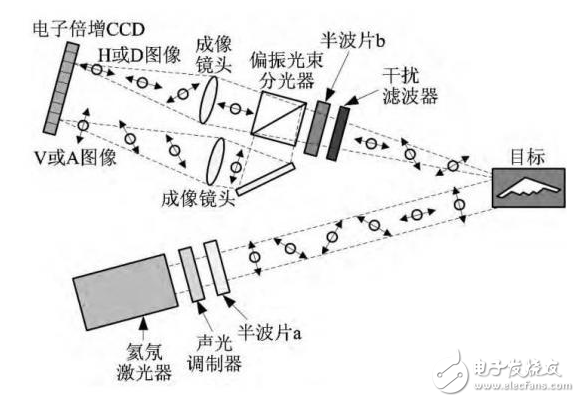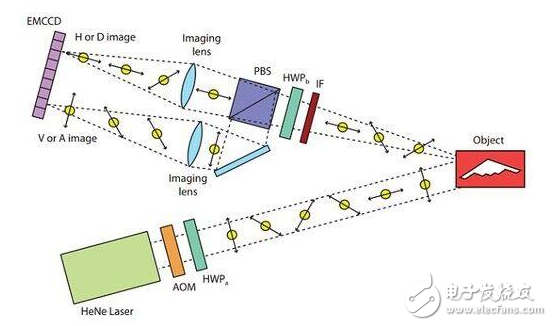Last month, China's first quantum radar system based on single photon detection was successfully developed in 14 and reached the international advanced level. The quantum radar system was developed by the 14 key laboratories of intelligent sensing technology of China Electronics University. Under the joint efforts of the China University of Science and Technology, the 27th China Electronics and Nanjing University, the quantum detection mechanism was completed through unremitting efforts. The research on the target scattering characteristics and the experimental verification of the quantum detection principle, and the target detection test in the real atmosphere under the external field, the detection power of 100 kilometers is obtained, the detection sensitivity is greatly improved, the indicators all achieve the expected effects, and the staged major research progress is obtained. And results.
After domestic scientific research teams have made technological breakthroughs in quantum communication and quantum computing, China has made another city in the field of quantum radar. So, what is special about quantum radar compared to classical radar?
Quantum radar is not a subversion of classic radar
The radar was first widely used during World War II, especially in the British air battles. The Royal Air Force relied on radar to assist the German Air Force. At that time, the radar simply used the transmitted electromagnetic wave signal, and after scattering through the target surface, it recognized and judged the target by judging the energy of the received signal. However, the information carrier of such a radar can only be reflected by the absolute amplitude or amplitude of the signal. The detection mechanism is simple energy detection, unable to distinguish between clutter and target, and can not distinguish the tinfoil strip and the real fighter flying in the air. The information utilization method is single, and therefore, the application field is greatly restricted.
With the development of technology, the radar has also changed constantly, from the pure use of the signal strength information to the comprehensive utilization of the frequency and phase information of the electromagnetic signal, that is, the second-order characteristics of the electromagnetic field. By applying the second-order characteristics of electromagnetic waves, complex signal forms such as chirp, phase encoding and agile are presented in the modulation mode. These signal forms effectively solve the contradiction between the traditional radar time width and bandwidth, and improve the radar anti-interference. Ability to resist clutter. In the detection technology, dynamic target detection technology, space-time adaptive processing technology and pulse Doppler system are generated. These techniques use the difference of target and clutter in the Doppler domain to realize the effective detection of moving targets in clutter. Improve radar anti-clutter ability.
Quantum radar introduces quantum information technology into the field of classical radar detection, solves the technical bottleneck of classical radar in detection, measurement and imaging, and improves the comprehensive performance of radar. Quantum radar is a new concept radar. The primary application is to achieve the detection of the target. On this basis, the application fields can be further expanded, including quantum imaging radar, quantum ranging radar and quantum navigation radar. In essence, quantum Radar does not deviate from the framework of classical radar detection. It only has a new and more accurate understanding of some concepts and physical phenomena in radar, such as receiver noise, when using quantum theory for system analysis. On this basis, quantum radar starts from the aspects of information modulation carrier and detection processing to improve the performance of radar. In general, quantum radar is an update and supplement to the classic radar theory, not subversion and replacement.
Classification of quantum radar
According to the difference in the use of quantum phenomena and photon emission mechanisms, quantum radar can be mainly divided into the following three categories:
First, the quantum radar emits non-entangled quantum state electromagnetic waves. The transmitter transmits a single photon pulse to interrogate the possible area of ​​the target. If the target exists, the signal photon will return to the receiver with a certain probability, and the target information can be extracted by measuring the return photon state.
Second, the quantum radar emits entangled quantum electromagnetic waves. The detection process uses a pump photon to pass through the (BBO) crystal, and a large number of entangled photon pairs are generated by parametric down-conversion. The polarization states between the entangled photon pairs are orthogonal to each other, and the entangled photons are divided into probe photons and imaging photons. The imaging photons are retained in the quantum memory. The detected photons are transmitted by the transmitter and reflected by the target, and then received by the quantum radar. According to the entanglement of the detected photons and the imaged photons, the detection performance of the radar can be improved. The entangled quantum radar resolution is increased at the quadratic rate compared to a quantum radar that does not use entanglement.
The third is that the radar emits classical electromagnetic waves. Quantum enhanced detection technology is used at the receiver to improve the performance of the radar system. Currently, this technology has a wide range of applications in laser radar technology. The CLP 14 actually applies one of the above three modes.


Technical advantages of quantum radar
At present, the classic radar has some shortcomings, one is that the transmission power is large (tens of kilowatts), the electromagnetic leakage is large; the second is that the anti-stealth capability is relatively poor; the third is that the imaging capability is relatively weak; the fourth is that the signal processing is complex and the real-time performance is weak. In view of the technical difficulties of classical radar, quantum information technology has certain technical advantages, and can improve the detection performance of radar by combining with classical radar.
First of all, the information carrier in quantum information technology is a single quantum. The objects of signal generation, modulation and reception, and detection are all single quantum. Therefore, the entire receiving system has extremely high sensitivity, that is, the noise floor of the quantum receiving system is extremely low. Compared to classical radar receivers, the noise floor can be reduced by several orders of magnitude. By ignoring the implementation factors such as the working frequency band, clutter and dynamic range, the radar action distance can be greatly increased by several times or even tens of times. This greatly enhances the radar's ability to detect weak targets and even stealth targets.
Secondly, the modulation object in quantum information technology is a quantum state. Compared with the information modulation object of classical radar, the quantum state can represent microscopic information such as quantum "fluctuation change", which has higher order than classical time, frequency and polarization. Information, that is, the modulation information dimension is higher. From the perspective of information theory, more performance can be obtained by operating high-dimensional information. For target detection, high-order information modulation can further reduce the noise floor without affecting the accumulation benefit, thereby improving the ability of weak target detection in noise; from the perspective of signal analysis, by performing quantum high on the signal The order micro-modulation makes it difficult for the traditional signal analysis method to accurately extract the information modulated in the levied signal, thereby improving the anti-listening ability in the electronic countermeasure environment. In summary, through the introduction of quantum information technology, by quantum receiving, in principle, the noise floor power in the received signal can be effectively reduced; by quantum state modulation, the dimension of information processing can be increased in principle, and the signal-to-noise ratio can be improved on the other hand. Benefits, on the other hand, can reduce the possibility of accurate analysis and replication of the transmitted signal, thus having broad application potential in the field of target detection and electronic countermeasures.
At the international advanced level
According to experts, in fact, relevant research has been done for many years. The previous work on quantum imaging has not been done at the single photon level, but with the high-order correlation characteristics of light. It does have the characteristics of breaking through clouds and so on. However, the imaging process is still relatively complicated, the process is long, the practicality needs to be developed, and it is difficult to call quantum imaging. It can be said that the technological breakthrough achieved this time is the result of years of technical accumulation, not to catch up with the quantum heat that the recent "Mozi" has set off.
This technological breakthrough belongs to the field of quantum detection. It is characterized by breaking through the classical limits of current measurement methods (such as the diffraction limit of light, etc.), which is a relatively promising technology in the industry (and, of course, some scholars disagree). Countries all over the world have also studied this, and the technology has developed rapidly. In 2008, Professor Lloyd of the Massachusetts Institute of Technology proposed the quantum remote detection system model—quantum illumination radar. It theoretically proved that quantum mechanics can be applied to remotely. Target detection. In 2012, Nakamura and Yamamoto of the University of Tokyo used superconducting loops to achieve new breakthroughs in the generation and reception of single-photon and squeezed states in the microwave band. In 2013, Italy's Lopaeva et al. first realized the quantum irradiation radar by experimental method. Based on the photon number correlation, this experiment verified that the quantum illumination radar model proposed by Lloyd still has the target detection capability in high noise and high loss. In 2015, Shabir Barzanjeh of Aachen University of Technology in Germany conducted in-depth research on microwave quantum illumination detection.
At present, China is only at the advanced level of technology in this field. It is still not in a leading position. The revolution has not yet succeeded. Comrades still need to work hard.
A flange can also be a plate or ring to form a rim at the end of a pipe when fastened to the pipe. A blind flange is a plate for covering or closing the end of a pipe. A flange joint is a connection of pipes, where the connecting pieces have flanges by which the parts are bolted together.
Although the word flange generally refers to the actual raised rim or lip of a fitting, many flanged plumbing fittings are themselves known as 'flanges':
There are many different flange standards to be found worldwide. To allow easy functionality and interchangeability, these are designed to have standardised dimensions. Common world standards include ASA/ASME (USA), PN/DIN (European), BS10 (British/Australian), and JIS/KS (Japanese/Korean). In the USA, ANSI stopped publishing B16.5 in 1996, and the standard is ASME B16.5
Stainless Steel Flange,Machining Stainless Steel Flange, Stainless Steel Pipe Fitting Flange,Galvanized Stainless Steel Flange
Yixing Steel Pole International Trading Co., Ltd , https://www.yx-steelpole.com
